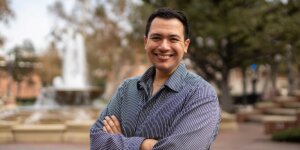 The need for renewable energy to address climate change is urgent—but how do we map the energy transition to that goal? Answers to this question are vital as we move towards energy transition on a global scale. These challenges are the focus of the newly established Ershaghi Center for Energy Transition (E-CET), launched with a gift from Viterbi alumnus Gary Buntmann and Mary Buntmann.
The need for renewable energy to address climate change is urgent—but how do we map the energy transition to that goal? Answers to this question are vital as we move towards energy transition on a global scale. These challenges are the focus of the newly established Ershaghi Center for Energy Transition (E-CET), launched with a gift from Viterbi alumnus Gary Buntmann and Mary Buntmann.
E-CET held its first summit earlier this year. The gathering brought together stakeholders who assessed the energy landscape, the energy transition, and related technical, economic, and policy issues.
Welcoming the audience, Ishwar Puri, Senior Vice President, Research, and Innovation at USC emphasized the critical role E-CET will play in this important area. Yannis C. Yortsos, Dean of the USC Viterbi School of Engineering, noted that the summit “brings to the fore the critical tasks we face ahead as we consider the transition of energy toward low-carbon emissions and a more sustainable energy future.”
The day-long summit highlighted a wide range of issues. Don Paul, Executive Director of the USC Energy Institute, reiterated that the scale and scope of the energy transition “are enormous, and the corresponding time longer than expected”. “Many issues will not be solved solely by policymaking and behavioral changes. The responsibility lies not just with policymakers but also with technologists.” And as Warner Williams, a veteran of the energy industry mentioned, “Technology innovation underpins it all.”
Professor Ershaghi, member of the NAE, and in whose name the center was dedicated, expressed the expectation that this summit and future events will begin to address topics of crucial interest to the public “regarding energy requirements and current and future energy sources.” The hope is that E-CET will be one of the catalysts for such discussions.
Said Warner Williams, a financial supporter of the E-CET event, “This transition is a period when fossil fuel and growing clean energy systems will co-exist, as both are required to function well to deliver the energy needed for the world.”
The summit provided the opportunity to showcase how E-CET is sponsoring a number of seed fund research projects. Kelly Sanders, professor in Civil and Environmental Engineering, is working on developing a new way “to estimate the greenhouse gas emissions consequences of consuming electricity at an hourly time-resolution, which is a difficult challenge given that solar, wind, and hydropower generation vary significantly by season of the year and by hour of the day on regional power grids.” The task is essential, says Sanders, as “developing accurate estimates of the emission consequences of consuming electricity is a critical priority for decarbonization efforts.”
Priya Vashishta, professor in Chemical Engineering and Materials Science, is leading another E-CET sponsored project. His work is focused on hydrogen as a fuel source, which is difficult to transport and store. While “green hydrogen” is an ideal fuel, as its combustion only emits water vapor, creating hydrogen from the reverse reaction, namely hydrolysis, and requires its own energy. Vashishta’s focus is producing hydrogen from ammonia, in a process that yields what is called “blue hydrogen.” Vashishta is trying to find a way to manage the carbon dioxide emitted from this process and safely store it in the ground.
Other projects supported by E-CET include capturing and converting carbon dioxide to other useful products, an effort led by Professors Jessen and Tsotsis; repurposing idle oil and gas wells for subsurface storage energy from renewables, led by Professor Jha; and CO2 conversion led by Professor Shamma Sharada. E-CET also supports a project by Professor Viktor Prasanna on “real-time storage integrated operations of the smart grid.”
By cultivating these projects, the Center is acting on what one of its participating panelists, Gracie Brown, Associate Partner, McKinsey & Company, recommended, namely an evaluation of new modalities, processes, or investments. These faculty projects are just the starting point. But the potential impact, if successful, could be significant. Al Williams, Vice President of Corporate Affairs at Chevron, a sponsor of the event, explained the stakes: “Energy is a key part of how societies progress,” he said.
Other speakers and attendees included NAE members Christine Economides from the University of Houston, Chip Zukoski moderating the luncheon speakers and the Daneshy Awards of the E-CET, Gary Buntmann, the benefactor of the Center, USC’s Professors Jay Lee and Noah Malmstadt, and industry experts and supporters Trem Smith, Shahram Farhadi, Rajan Chokshi, Jim Crompton, Roy Robinson, and Todd Stevens with expertise in the areas of energy, sustainability, and the environment. Molly Laegeler, Vice President of Chevron, discussed ways to advance a low-carbon future, while Med Kamal, the SPE President, discussed workforce issues related to the energy transition.
Genevieve Giuliano, professor at the Price School of Public Policy, focused on the various policy matters and on a number of key issues involved in total conversion to electric vehicles and electric trucks.
Those who helped with moderating the sessions included USC professors Don Paul, Priya Vashisha, and Behnam Jafarpour (E-CET Associate Director) and industry experts Mike Hauser and Steve Shryock.
Finally, during the summit, a number of awards were announced. The recipients of the 2023 Daneshy Awards for innovative areas in Energy Transition included Professor Surya Prakash of USC, Professor Qingwang Yan from Texas Tech, and Gege Wen from Stanford University.
The master of ceremonies for the entire summit was Elizabeth Arnold Weiss from USC.
The next event/workshop for E-CET will be on March 18, 2024, more information can be found at: https://ECET.usc.edu/
Published on May 15th, 2023
Last updated on October 30th, 2024













